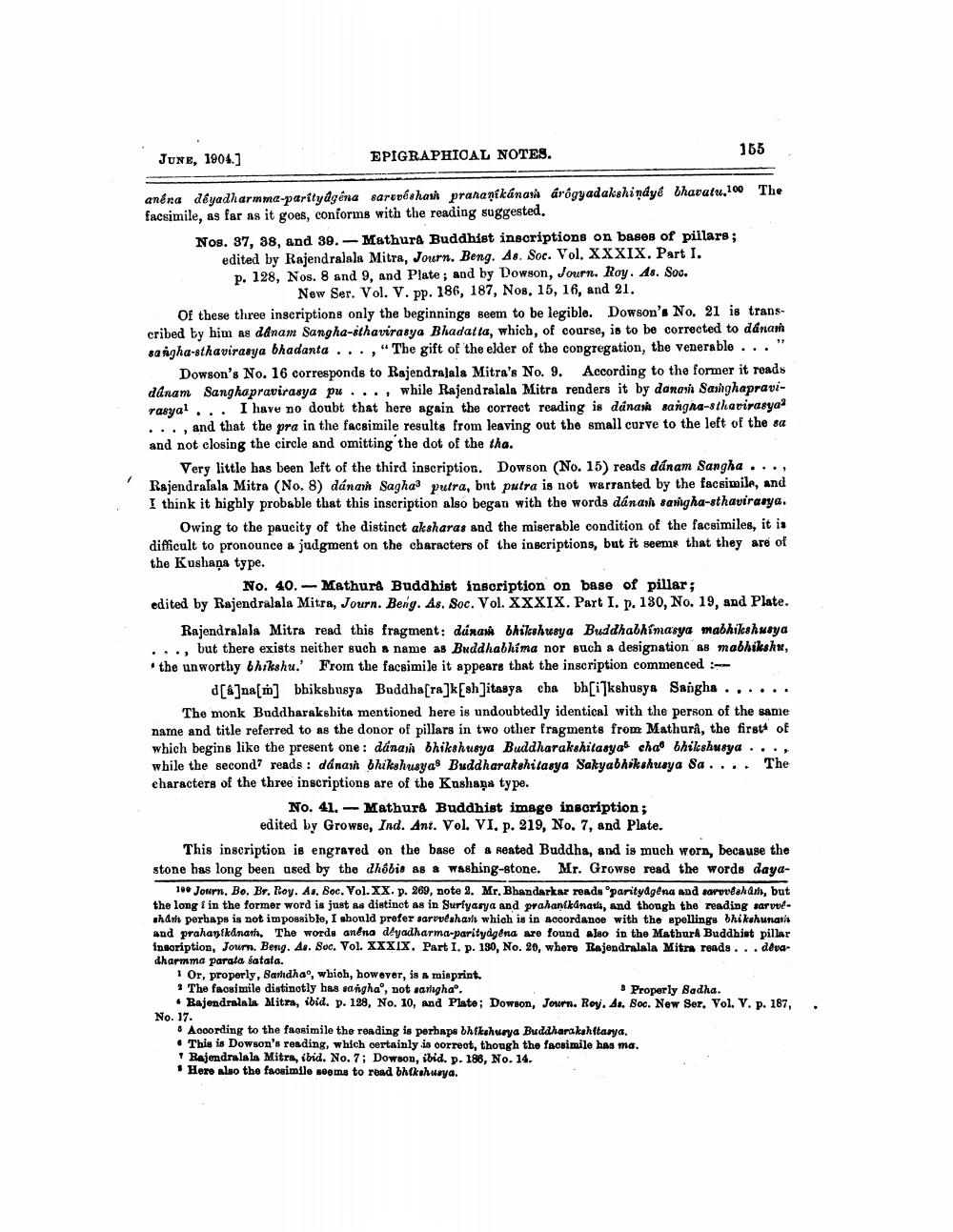________________
JUNE, 1904.)
EPIGRAPHICAL NOTES.
165
anera deyadharmma-paritydgéna sarvoéshash prahanikánari árôgyadakshindye bhavatu.100 The facsimile, as far as it goes, conforms with the reading suggested.
Nos. 37, 38, and 39.-Mathura Buddhist inscriptions on bases of pillars;
edited by Rajendralala Mitra, Journ. Beng. As. Soc. Vol. XXXIX. Part I. p. 128, Nos. 8 and 9, and Plate ; and by Dowson, Journ. Roy. 48. Soc.
New Ser. Vol. V. pp. 186, 187, Nos, 15, 16, and 21. Of these three inscriptions only the beginnings seem to be legible. Dowson's No. 21 is transcribed by him as dånam Sangha-sthavirasya Bhadatta, which, of course, is to be corrected to dánan sa ngha-sthavirasya bhadanta ..., "The gift of the elder of the congregation, the venerable ..."
Dowson's No. 16 corresponds to Rajendralala Mitra's No. 9. According to the former it roads danam Sanghapravirasya pu..., while Rajendralala Mitra renders it by donasi Sarighapravirasyal ... I have no doubt that here again the correct reading is danas sangha-sthavirasya ..., and that the pra in the facsimile results from leaving out the small curve to the left of the sa and not closing the circle and omitting the dot of the tha.
Very little has been left of the third inscription. Dowson (No. 15) reads dánam Sangha ..., Rajendralala Mitra (No. 8) dánarh Sagha3 putra, bnt putra is not warranted by the facsimile, and I think it highly probable that this inscription also began with the words dánara samgha-sthavirasya.
Owing to the paucity of the distinct aksharas and the miserable condition of the facsimiles, it is difficult to pronounce a judgment on the characters of the inscriptions, but it seems that they are of the Kushaņa type.
No. 40.- Mathura Buddhist inscription on base of pillar; edited by Rajendralala Mitra, Journ. Beng. As. Soc. Vol. XXXIX. Part I. p. 130, No. 19, and Plate.
Rajendralala Mitra read this fragment: dúna bhilashusya Buddhabhímasya mabhikshwaya ..., but there exists neither such a name as Buddhabhima nor such a designation as mabhikshu, . the unworthy bhikshu.' From the facsimile it appears that the inscription commenced
[4]na[m] bhiksbusya Buddha[ra]k[sh]itasya cha bh[ikshusya Sangha ...... The monk Buddharakshita mentioned here is undoubtedly identical with the person of the same name and title referred to as the donor of pillars in two other fragments from Mathura, the first of which begins like the present one: dánari bhikshusya Buddharakshitasyam cha bhikshusya ..., while the second? reads : dánan bhikshusya Buddharakshitasya Sakyabhikshusya Sa.... The characters of the three inscriptions are of the Kushana type.
No. 41. -- Mathura Buddhist image inscription;
edited by Growse, Ind. Ant. Vol. VI. p. 219, No. 7, and Plate. This inscription is engraved on the base of a reated Buddha, and is much worn, because the stone has long been used by the chóbis as a washing-stone. Mr. Growse read the words daya
19 Journ. Bo. Br. Roy. As. Soc. Vol. XX. p. 269, note 2. Mr. Bhandarkar reads "paritydgend and sarvesham, but the long i in the former word is just as distinct as in Suriyasya and prahanikunath, and though the reading sarvvéshat perhaps is not impossible, I should prefer sarvvéshan which is in accordanoe with the spellings bhikshunath and prahankdnania. The words anena deyadharma-paritydgena are found also in the Mathord Buddhist pillar insoription, Journ. Beng. As. Soc. Vol. XXXIX. Part I. p. 130, No. 20, where Rajendralala Mitra reads... devadharmma parata satata.
1 Or, properly, Samdhao, wbich, however, is a misprint. · The faosimile distinotly has sangha', not sanghao.
9 Properly Sadha. • Bajendralala Mitra, ibid. p. 128, No. 10, and Plato; Dowson, Journ. Roy. As. Soc. New Ser, Vol. V. p. 187, No. 17.
According to the facsimile the reading is perhaps bhikshweya Buddharakahitanya. . This is Dowson's reading, which certainly is correot, though the facsimile has ma.
Rajendralala Mitra, ibid. No. 7; Dowson, ibid. p. 186, No. 14. • Here also the facsimilo seems to read bhikshusya.
.




